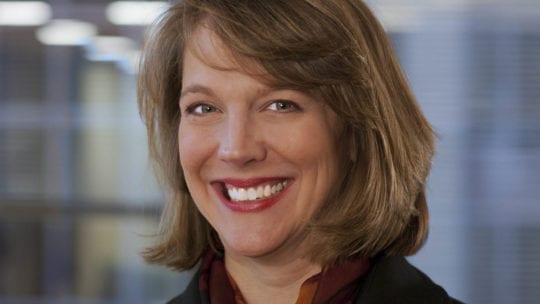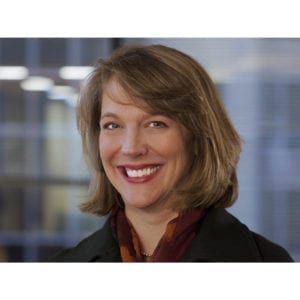
[Editor’s Note: Marjorie Benzkofer recently was named chief strategy officer at FleishmanHillard. The 20-year agency veteran will also continue to head global reputation management. We asked the one-time journalist and brand communicator about how to keep a global firm working smoothly, measuring success and why so many brands seem to stumble with reputation issues. Her edited responses are below.]
PRNEWS: Why does FleishmanHillard (FH) need a chief strategy officer now?

Chief Strategy Officer
FleishmanHillard
Marjorie Benzkofer: We have to be constantly re-inventing the client experience. That requires looking across all of the parts of our business clients depend on–whether that’s our capabilities, our geographic network, how we are growing our talent or incubating innovations. The pace of change requires our effort be more integrated; we simply can’t operate successfully in silos–either by offices or practices or any other function. We are a group of ambitious people who are attracted to difficult challenges. In my role as chief strategy officer, I’ll help connect those ambitions to ensure we’re delivering the very best short- and long-term client experience.
PRNEWS: Connecting ambitions leads to the next question. Your CEO/president John Saunders told us about a dinner he had with the conductor, Sir Simon Rattle. He asked the maestro about his then-orchestra, the Berlin Philharmonic. Is it the best orchestra in the world? “It is,” Sir Simon replied, “when we play together.” Sir Simon wasn’t joking. FH has offices in 30 countries. How do you ensure roughly 4,200 employees work in concert? No pun intended.
Benzkofer: It starts with putting the client at the center. Our culture is such that when we do that, all other agendas become secondary. We work in 80+ locations around the world, but John and our leadership team are very effective at creating teams that work seamlessly across those locations. That starts with the very first experience a company has with FH when they enter the firm through our Global New Business function. When they become FH clients there are core functions that focus on creating a consistent experience across our network, including how we develop and support account leaders and how we bring new capabilities to clients with our global practices.
PRNEWS: You’re going to continue to oversee the reputation management capability. We know about the Authenticity Gap that FH espouses regarding brands and values. Why do so many companies stumble trying to align actions with their values? Besides becoming a client of FH, what do you recommend companies do to make sure they don’t fall into this predicament?
Benzkofer: Too often company values are written very broadly. For example: “We take care of the community.” That means different things to different people when it comes to something like gun safety. So when companies dig deeper to decide how to act against very broadly defined values, they run into two pretty common pitfalls:
- They forget to consider all of their audiences. It’s so important to take a 360-degree view of ALL of your stakeholders when making decisions that impact your business–not just your target customer, but your employees, your business partners, regulators and more. Companies need to look across the entire landscape and ensure they don’t have any blind spots.
- They assume they know what their stakeholders think. It’s very easy to make assumptions about how employees will or won’t react to something. Today, there are tribes within all of the traditional stakeholder bases and there is no substitute for data–you can’t go on gut instinct alone.
Only when companies have a hold of a realistic picture of the landscape of their audiences can they make informed decisions about how to act against their values and then manage the consequences of those who may disagree.
It’s a remarkably dynamic time to be managing corporate reputation and collaborating with others in real-time. There are lessons learned and best practices emerging daily.
PRNEWS: You are responsible for “measuring the collective progress of the agency.” How is this done and how often?
Benzkofer: You have to start measurement with the end in mind. That means when we set a goal, we have to be able to define, very specifically, what success looks like. In addition, what systems we have in place to measure that success.
Of course, every business uses financial metrics, but it’s more interesting to look what drives that financial outcome. I’ll use a sports analogy: You can look at the final score of the game, but it’s really when you look deeper into the stats and the stats by player that you understand why one team outperformed the other.
The same is true for our business. We have to look deeper into what drives our client engagement scores, how our network is performing, what the changing needs of our talent are and what capabilities clients find meaningful or not.
PRNEWS: You’re known for promoting a nimble workforce. How do you do that at FH?
Benzkofer: The old question we used to get from clients was: “Where are your offices that make up your global network?”
The new question we get today is: “How is your network wired so you can turn on the right talent when I need them?”
This requires a different kind of mobility and a different way of knowing where our expertise lives within our network.
Today, our practice and sector leaders are responsible for mapping our talent by the “sweet spots” of our various capabilities so we can better find the right person within our network who has the industry and skill expertise, along with the experience a client needs.
Employees create online “passion bios” about their work experience as well as their personal passions. So when a client needs a stellar video script, written by someone with a deep knowledge of professional wrestling and passion for online sports, we have them covered.
We also have introduced the role of agency talent broker. These brokers track staff and workloads across the network with an “air traffic control” view so we can set up the right staffing mix for clients with a 3-month or 6-month view, based on what we see in our upcoming client scopes.
PRNEWS: What are your goals with your new position?
Benzkofer: While the role was only recently formalized, I think what is going to be most interesting to look at is:
- More nimble talent. The challenges our clients face today may look different in a month. We need to put dynamic teams into place so that we can mobilize the right expertise at the right moment for clients.
- More sophisticated and integrated solutions. Client functions aren’t as siloed as they used to be. Neither can the recommendations we bring forward–it’s never just a media program or an employee communication program. The answers have to address multiple needs–and that has to be true for clients of all sizes, not just big global companies.
- More engagement with our business strategy. When employees understand and are aligned with strategic priorities, they are better equipped to quickly access and leverage elements of the strategy that enhance our support of clients and their own work experience.
CONTACT: Chelsey.Watts@fleishman.com
